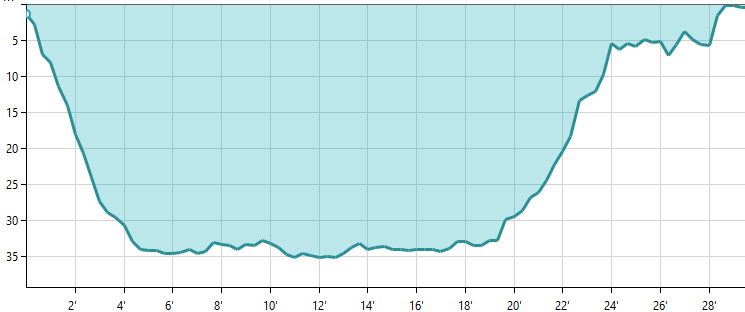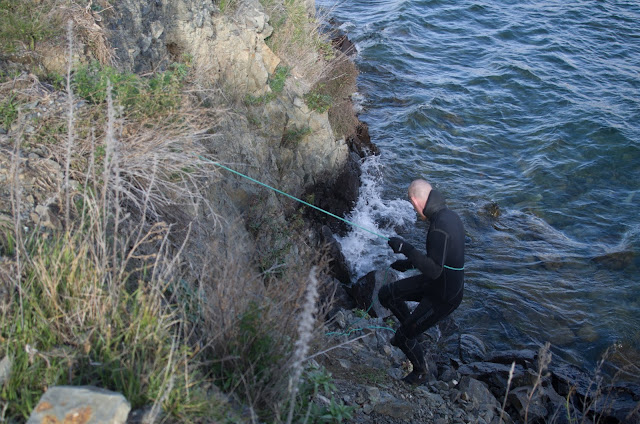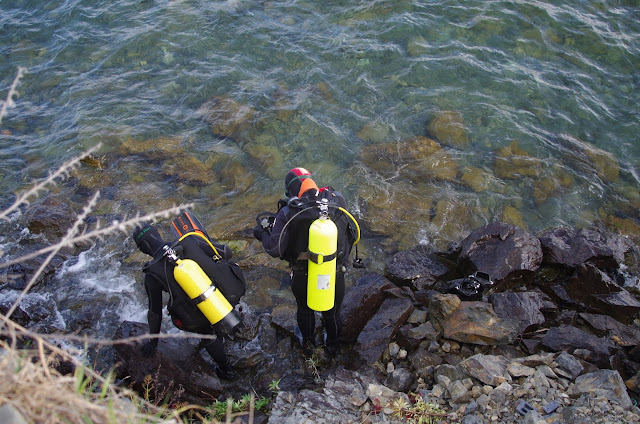After our previous
trip where we discovered a forest on the bottom of Lake Aviemore we were eager
to return. With both of us having busy schedules, we managed to find a weekend
that we both had free so we could make the trek back up to the lake for another
dive. This time we knew what to expect and were keen to develop a solid plan of
attack.
Before we could delve into the deep, dark depths of the lake we both had some new equipment to trial in the shallows. Once we had arrived on Friday evening we got straight into setting up our gear and drove down to Loch Laird, a small offshoot on the side of the lake. Upon getting out of the truck we got a bit of a shock: there was already frost on the ground! Oh well... we only needed to spend a few minutes in the water to make sure everything was OK. We slipped into our gear and entered the water. For me it was getting a feel for my new Jet fins and Adam was trying out his new Transpac and Apeks RK3 fins. We were both absolutely stoked with how they felt and performed so after little more than 5 minutes in the shallow 3m Loch we decided it was time to hop out. The fact that it was 5°C (41°F) water may have influenced the decision as well.
We rose bright and early eager to get out to the lake and get in the water. I made the mistake at looking at the outside temperature as soon as I woke and gave myself a bit of a fright... -3°C (27°F). I managed to convince myself that air temperature didn't matter and the water would be warmer. We made our final preparations checking lights, cameras, and housings. We went out to load up the truck and got a bit of a shock. Upon opening up the back of the truck we discovered that our gear was frozen from the previous night’s dive. Not something that we'd encountered before but not something we couldn't handle. We continued loading up and hit the road for the short drive to the northern shores of the lake.
We arrived at our parking spot and quickly got the rope rigged up to get down the cliff to the waters edge. After figuring out what to do last time it was a much easier and smoother process. I abseiled down and Adam lowered the gear to me (it's quite easy when your buddy is the stronger one). After gearing up and recapping our dive plan we fired up the cameras and slipped below the surface. I'm not sure how it happens but I almost always end up leading while Adam follows, it works out well and we both end up happy (except when I make a mistake navigating). We slipped effortlessly into the depths passing a familiar boulder at 27m (90ft). Good, we're on the right track. Soon enough the bank flattened out and we were on the bottom. The forest drifted into view. It's an amazing experience drifting almost silently through the branches. Your mind slips 50 years into the past, imagining what the valley would have looked like before it was flooded all those years ago. Time slipped by quickly as I snapped a few photos of the forest and Adam. Soon enough we hit our limits and it was time to return to the surface. We made our ascent, shooting my surface marker on the way and completed our required decompression of 4 minutes at 6m (20ft). It was only upon reaching the surface that the cold truly hit us. We had intended to make a second dive later in the day but even before reaching the shore we knew that was not going to happen.
We then headed back to
the bach for some warmth and started to work on the plan of attack for the
mornings dive. Since we knew what depths and distances we would encounter our
planning process was pretty straightforward. Utilising our TDI Decompression
Procedures training in conjunction with Suunto DM5 planning software we
developed planned and contingency schedules for both our dive profile and gas
management. We settled on a plan of 15 minutes bottom time at 36m (118ft) which
fitted nicely with the gas we had available whilst minimising our required
decompression stops. With the dive planned and cameras charged we slipped off
to bed ready for an early start in the morning.
Dive Profile. Runtime: 29 min, Max depth: 35.2m (115ft)
Getting the gear up
the cliff was a little bit of a challenge this time. Adam was more than capable
of the physical lifting but for me it was a rather difficult to tie the gear to
the rope with my frozen fingers. Miraculously my knots held and the gear made
it up the cliff. After Adam had hauled the last of the gear up it was my turn
to clamber up and we quickly changed out of our wetsuits before driving back to
the bach. It was only after we had thawed ourselves thoroughly that we thought
to check what the bottom temperature actually was. The previous month it had
been 9°C (48°F) and the previous night in the Loch had been 5°C (41°F) so we
thought this would be the coldest it would be. Nope... 3°C (37°F) on the bottom
this time. No wonder we were cold.
Despite only making
one dive to the forest it was still a great trip. Now it's time to get the
drysuit fixed, sort out some better camera lighting, and finally get set up
with doubles to extend our bottom time. We'll get there eventually.
Here's a selection of photos from the dive:























